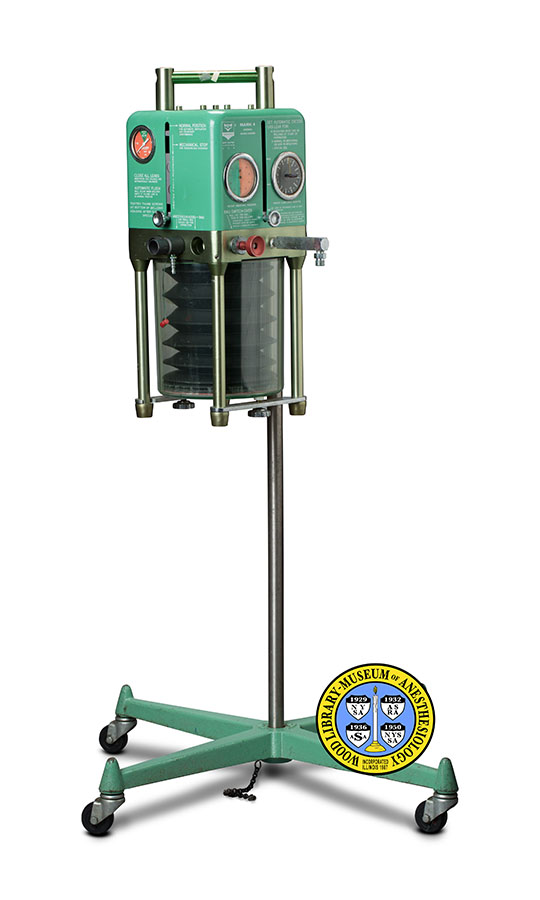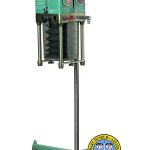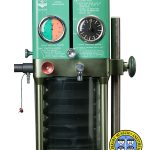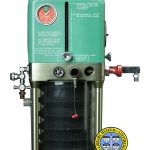Bird Mark 4
The Mark 4 Anesthesia Assistor/Controller was introduced by the Bird Corporation in 1959. It was used with one of the company’s ventilators to administer inhaled anesthetics and assist or control a patient’s breathing during surgery.
The Bird Corporation was founded by Forrest M. Bird, M.D., Ph.D. (1921-2015). Dr. Bird invented a number of popular medical devices that were used to care for patients with breathing problems. During WWII he served in the Army Air Corps where, in addition to training and transport assignments, he studied aircraft and respiratory and cardiovascular problems at high altitude. Two devices that he produced during the war went into the design of his first ventilator, the Mark 7.
A ventilator is a machine that helps a person breathe or takes over the work of breathing completely. The Mark 7 was introduced in 1957, when American physicians were beginning to use ventilators in greater numbers.
During anesthesia, the ventilator that was attached to the Mark 4 Assistor/Controller was used to adjust the rate of flow, timing, and pressure of the gases delivered to the patient’s lungs. The Mark 4 was used to determine the amount (or volume) of gas delivered to the patient’s lungs, display breathing system pressure, and set additional pressure release functions. Also, respiratory gases, such as air and oxygen, and anesthetic gases were mixed inside the bellows of the Mark 4 before being sent to the patient.
Catalog Record: Bird Mark 4
Access Key: amee
Accession No.: 1998-08-13-1 A1
Title: Mark 4 : anesthesia assistor/controller / Bird Corporation.
Author: Bird, Forrest M. (Forrest Morton), 1921-2015.
Corporate Author: Bird Corporation.
Title variation: Alt Title
Title: Bird mark 4 ventilator.
Title variation: Alt Title
Title: Bird Mark 4 positive/negative phase anesthesia respirator.
Title variation: Alt Title
Title: Bird mark 4 respirator.
Publisher: Palm Springs, California : Bird Corporation, [between 1959 and 1979?].
Physical Descript: 1 ventilator : metals, rubber, plastic ; 116 x 61 x 61 cm.
Subject: Ventilators, Mechanical.
Subject: Respiration, Artificial – instrumentation.
Subject: Anesthesia, Inhalation – instrumentation.
Note Type: General
Notes: The title was taken from the front of the device.
Note Type: General
Notes: The early year in the date range for the possible year of manufacture is
based on several resources that report that the Mark 4 was introduced in 1959
The end year is an estimate based on the year that the Mark 4A was
introduced (1979). The date range may change if documentation, or expert
opinion, indicates that it should be corrected.
Note Type: Citation
Notes: Bird displays new equipment in Miami, Fla. Desert Sun. October 1959;33(58):7B
https://cdnc.ucr.edu/cgi-bin/cdnc?a=d&d=DS19591021.2.104#. Accessed August 20
2015. [The Mark 4 is listed in the article.]
Note Type: Citation
Notes: Bird FM, Pohndord HL, inventors. Device for aiding in the administration of
gaseous anesthetic agents. U.S. patent 3,156,238. November 10, 1964. www.
google.com/patents/US3156238. Accessed August 20, 2015. [The patent
application was filed on February 18, 1960.]
Note Type: Citation
Notes: Fisher AJ, Bird FM, Pohndorf. Specifications for the bird® Mark 4 Anesthesia
Assistor/Controller. Palm Springs, California; bird corporation; [date not
indicated].
Note Type: Citation
Notes: McFadden RD. Dr. Forrest Bird, inventor of medical respirators and
ventilators, dies at 94. New York Times. August 3, 2015. https://www.nytimes.
com/2015/08/04/us/dr-forrest-bird-inventor-of-medical-respirators-and-ventila
ors-dies-at-94.html?_r=0. Accessed August 28, 2015.
Note Type: Citation
Notes: Mushin WW, Baker LR, Thompson PW, Mapleson WW. Historical background to
automatic ventilation. in: Automatic Ventilation of the Lungs. 3rd ed.
Oxford: Blackwell Scientific Publications; 1980:209.
Note Type: Citation
Notes: New products: anesthesia ventilator. Am J Physical Med. October,
1979;58(5):249. [Describes the new Mark 4A ventilator.]
Note Type: Citation
Notes: Sechzer PH. The Bird Assistor-Controller. In: The Bird Respirator. Revised ed
New York: Altneu; 1965:69-76.
Note Type: Citation
Notes: Severinghaus JW. History of blood gas analysis. III. Carbon dioxide tension.
J Clin Monit. 1986;2(1):70.
Note Type: Citation
Notes: Westhorpe RN, Ball C. The Bird ventilator. Anaesth Intensive Care.
2012;40(4):585.
Note Type: Physical Description
Notes: [1] One ‘bag-in-bottle’ assister/controller on a pole stand with wheels; The
upper portion of the device is painted a dark sea foam green color and
contains the controls, gauges, ports, etc.; The lower portion of the device
is where the bellows is held in a clear plastic container; The measurements
in the physical description field incudes the stand; The device alone (upper
portion and bellows canister) measures approximately 54 x 32.5 x 37 cm
(height x width x length); For reference purposes the side of the device with
the markings, “MARK 4 [new line] anesthesia [new line] assistor/controller”,
was considered to be the front of the device; Also on the front, upper
portion of the device is a bellows pressure gauge and a “spirometer” gauge;
The bellows pressure gauge is located on the left side and is separated from
the right side by a vertical opening where the Excess Gas Leak knob may be
adjusted up or down to three marked locations; The marking, “MARK 4 [new
line] anesthesia [new line] assistor/controller”, is located above the
bellows pressure gauge; To the left of this marking is the “bird corporation”
logo, with the location printed below it: “palm springs [new line]
california” [new line] u s a”; The bellows pressure gauge is marked, “PATIENT
BREATHING PRESSURE” just below the gauge; The gauge is marked in centimeters
of water (cm h2o) from 40 cm h2o pressure to 40 cm h2o vacuum; Below this
gauge are instructions for switching from the temporary breathing bag to the
bellows; The instructions include, “BAG SWITCH-OVER [new line] PULL OUT FOR
BAG … [new line] PUSH IN FOR BELLOWS [new line] IMPORTANT … KEEP O RINGS
[new line] 9993557 SLICK BY USING [new line] SPECIAL LUBRICANT 993631; An
arrow points to the bag switch-over lever; On the right side of the front of
the device, above the spirometer gauge, are instructions for setting the
excess gas leak; Above the gauge is the following, “SET AUTOMATIC EXCESS GAS
LEAK FOR: [new line] III. ELEVATING BASE LINE OF BELLOWS AT START OF
INSPIRATION. [new line] II. NORMAL RE-BREATHING OR NON RE-BREATHING [new
line] I. SPECIAL USE.”; Just below the “spirometer” gauge, it is marked,
“PATIENT COMPLIANCE MONITOR”; The spirometer is marked every half increment
and numbered at whole numbers from 0 to 11; Instructions continue below the
spirometer, and include, “SET ZERO AT REFERENCE LINE AT END OF EXPIRATION.
[new line] ESTABLISH RESPIRATOR SETTINGS BY VISUALLY MONITORING CHEST
EXCLUSION. [new line] At constant settings changes in dial readings may be
used to determine patient response to anesthetic agents.”; Below these, an
adapter, that attaches to the swivel inlet of a Bird ventilator, extends
forward; A handle is located on the top of the device; A sticker with the
following markings is also located on the top of the device: “INSTRUMENTATION
ASSOCIATES INC. [new line] 17 WEST 60TH STREET NEW YORK, N.Y. 10023212 CI
5-0840″; A clamp for the stand is located on the right side of the device;
Two stickers are also on the right side; The stickers are marked with The
following, “PROPERTY OF 28518 ROSWELL PK. MEM. INST. [next sticker]
ENGINEERING & MAINTENANCE [new line] CONTROL NO. [new line] 1363 IT [new
line] ROSWELL PARK MEM. INST.”; The left side of the device is divided in
half by a vertical opening along which the volume limit knob can be adjusted;
On the left side is a line pressure gauge marked in pounds per square inch
(psi); It is numbered at 0, 20, 40, 60, 80 and 100; The area between 40 and
60 is colored green while the remainder of the area of the gauge is colored
red; Inside the green area of the gauge is the following text, “operating
press. 40-60″ … [continued at 2].
Note Type: Physical Description
Notes: [2 – continued from 1] …Below the gauge are instructions, including, “CLOSE
ALL LEAKS [new line] ANESTHESIA GAS VOLUMES ARE AUTOMATICALLY BALANCED [new
line] AUTOMATIC FLUSH WILL OCCUR WHEN BELLOWS EMPTY IF VOLUME LIMIT IS IN
NORMAL POSITION [new line] TIGHTEN THUMB SCREWS AT BOTTOM OF BELLOWS HOUSING
AFTER CLEANING SPECIAL PORT”; An arrow points downward, to where the special
port is located; Position markings and instructions are on the right side of
the vertical opening for the volume knob; These included, “NORMAL POSITION
FOR AUTOMATIC VENTILATION AND PULMONARY CONFORMANCE [new line] MECHANICAL
STOP FOR REDUCING GAS EXCHANGE [new line] DECREASE TITLE VOLUME [new line]
ANESTHESIA HOSE CAP SMALL SIDE OUTLET ON THIS CONNECTION [an arrow points to
the port for the anesthesia hose, to the right of this an arrow point to an
opening for a reservoir bag connection. The arrow is labeled] BAG”; On te
back of the device is a lage opening that is covered by a perforated disc;
The disc is clear and mounted so that it pivots left and right; Mark on the
upper left side of the back is the following, “DESIGNED FOR PUBLIC USE UNDER
PROF. ENG. LIC. NO. M.E. 2849-HLP STATE OF California [new line] MADE IN U.S.
A. [new line] PAT. 3,156,238″; Marked on the lower right corner of the back,
just above the inlet for oxygen, is, “OXYGEN SUPPLY VALVE [new line] PULL
OPEN OR CLOSE”; On the back of the canister for the bellows is a port to
which the ventilator would be attached; Arrows with the words “ON” and “OFF”,
and the text, “OXY”, mark the knob for the oxygen supply; The pole stand is
painted a sea foam green color, and has four legs; The legs end with wheels;
A drag chain descends from the bottom center of the stand’s legs; At the base
of the pole, from where the legs extend, is the Bird Corporation logo and the
word, “bird”.
Note Type: Reproduction
Notes: Photographed by Mr. Steve Donisch, June 5, 2015.
Note Type: Acquisition
Notes: Donated to the WLM by Mark Lema, M.D. Donation facilitated by Robert Sands, M
D.
Note Type: Historical
Notes: The Mark 4 Anesthesia Assistor/Controller was introduced by the Bird
Corporation in 1959. It was used with one of the company’s ventilators to
administer inhaled anesthetics and assist or control a patient’s breathing
during surgery.
The Bird Corporation was founded by Forrest M. Bird, M.D., Ph.D. (1921-2015).
Dr. Bird invented a number of popular medical devices that were used to care
for patients with breathing problems. During WWII he served in the Army Air
Corps where, in addition to training and transport assignments, he studied
aircraft and respiratory and cardiovascular problems at high altitude. Two
devices that he produced during the war went into the design of his first
commercially released ventilator, the Mark 7. According to John W.
Severinghaus, M.D., the early Bird Ventilators were manufactured for Bird by
the National Welding Company. Dr. Bird recommended this company as a
manufacturer for the carbon dioxide electrodes that became part of the first
three-function blood gas analyzer designed by Dr. Severinghaus and Mr.
Freeman Bradley.
A ventilator is a machine that helps a person breathe or takes over the work
of breathing completely. The Mark 7 was introduced in 1957, when American
physicians were beginning to use ventilators in greater numbers. At the time,
only a few other ventilators were available in the U.S. The Mark 7 was
smaller and lighter than the others and was one of the first ‘pneumatically
driven’ ventilators. This means it was powered by compressed gas from a
cylinder or piped source, and did not require electricity to function.
The Mark 4 Assistor/Controller was attached to a Mark 7 ventilator, as well
as the breathing system of the anesthesia machine. Mark 8 and 10 Ventilators,
introduced a few years later, were also used with the Mark 4.
During anesthesia, the ventilator that was attached to the Mark 4
Assistor/Controller was used to adjust the rate of flow, timing, and pressure
of the gases delivered to the patient’s lungs. The Mark 4 was used to
determine the amount (or volume) of gas delivered to the patient’s lungs,
display breathing system pressure, and set additional pressure release
functions. Also, respiratory gases, such as air and oxygen, and anesthetic
gases were mixed inside the bellows of the Mark 4 before being sent to the
patient. Safety features of the Mark 4 included an alarm, which sounded if
there was a leak in the breathing system, and was followed by an automatic
refill of the system with oxygen.
In 1979, the company introduced the Mark 4A, which combined the Mark 4
functions and ventilator functions into one machine.
Note Type: Exhibition
Notes: Selected for the WLM website, June, 2015.




